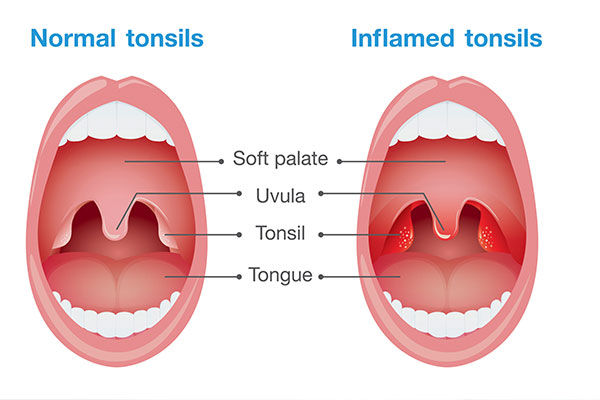Tonsils and Adenoids in Children
Tonsils are small, round pieces of tissue located in the back of the mouth on both sides of the throat. The adenoid is a clump of tissue behind the nose above the roof of the mouth.
During the first few months of life, the tonsils and adenoids produce antibodies that may help the body’s immune system defend against incoming bacteria and viruses.
Tonsils and adenoids may become enlarged due to infection and are removed during a tonsillectomy and adenoidectomy procedure.
After a tonsillectomy and adenoidectomy, studies reveal that patients with recurring infections experienced significant improvement.
Indications for a Tonsillectomy and Adenoidectomy
Recurring infections may indicate a need to remove the tonsils and adenoids. Considerations include the following:
- Recurrent or resistant infections
- Trouble breathing, sleeping, or swallowing. Enlarged tonsils and adenoids are often associated with chronic mouth breathing, affecting facial growth and dental occlusion.
- Peritonsillar abscesses
- Persistent foul taste or bad breath
- Sore throat due to chronic tonsillitis or tonsilloliths (yellowish-white debris in the depressions of tonsils)
- Recurring ear infections
- Chronic rhinitis or sinusitis (nose or sinus infections) unresponsive to antibiotics
Tonsillectomies and adenoidectomies are generally performed as outpatient procedures. Children less than three years of age spend the first night at the hospital for observation.
Recovery after tonsillectomy can take several days and may result in missed school or extracurricular activities.
Expert Care for Children’s Tonsils & Adenoids in Atlanta, GA
If your child faces frequent throat infections, breathing difficulties, or sinus issues, our pediatric ENT specialists in Atlanta can help. We offer tonsillectomy and adenoidectomy, along with personalized care to improve your child’s health and well-being. Serving families in Alpharetta, Duluth, and Marietta, we’re here to help your child breathe easier and sleep better. Contact us today to schedule a consultation.


